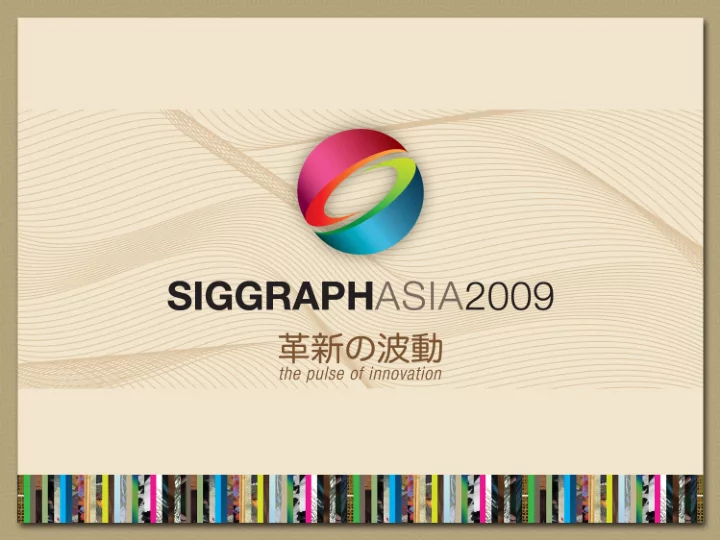

Approximating Subdivision Surfaces with Gregory Patches for Hardware Tessellation Charles Loop Scott Schaefer Microsoft Research Texas A&M University Tianyun Ni Ignacio Castaño NVIDIA NVIDIA
Goal Real- Time Displaced „Subdivision Surfaces‟
Problem: Real-Time Animation •Each vertex „touched‟ at runtime – new position influenced by many bones weights or morph targets • Costly for dense meshes • Coarse meshes are used – faceting artifacts • Dense static objects – high disk/bus consumption
Solution: Hardware Tessellation • Store/send coarse mesh to GPU • Animate coarse mesh vertices – inexpensive • Expand geometry on GPU – reduce bus traffic – exploit GPU parallelism • Better shape fidelity – reduced faceting – displacement mapping
Tessellation Pipeline • Direct3D11 has support for programmable tessellation Input Assembler Vertex Shader • Two new programable shader stages: Hull Shader • Hull Shader (HS) Tessellator • Domain Shader (DS) Domain Shader • One fixed function stage: Geometry Shader • Tessellator (TS) Setup/Raster
Hull Shader (HS) • Transforms control points from Input Assembler irregular control mesh data to Vertex Shader regular patch data Hull Shader • Computes edge tessellation Tessellator factors Domain Shader Geometry Shader Setup/Raster
Tessellator (TS) • Fixed function stage, but Input Assembler configurable Vertex Shader Hull Shader • Domains: – Triangle, Quad, Line Tessellator Domain Shader • Spacing: – Discrete, Continuous, Pow2 Geometry Shader Setup/Raster
Tessellator (TS) Level 5 Level 5.4 Level 6.6
Tessellator (TS) Left = 3.5 Right = 4.4 Bottom = 3.0 Top,Right = 4.5 Bottom,Left = 9.0 Inside Tess: Inside Tess: Inside Tess: minimum average maximum
Domain Shader (DS) Input Assembler Vertex Shader Hull Shader Tessellator Domain Shader Geometry Shader Setup/Raster
Subdivision Surfaces Catmull, E. AND Clark, J. 1978 , Recursively generated B-spline surfaces on arbitrary topological meshes subdivision • Already in the content creation pipeline • Used extensively in film and game industries • Coarse mesh input leads to smooth higher order surface
Problem: Infinite number of patches subdivision • Does not easily fit hardware tessellation paradigm • Stam, J. 1998 , Exact evaluation of Catmull-Clark subdivision surfaces at arbitrary parameter values • Using exact evaluation possible, but expensive • Need two levels of subdivision to get started • Eigen basis function storage/evaluation costly
Approximation Schemes • Loop, C. AND Schaefer, S. 2008 , Approximating Catmull-Clark subdivision surfaces with bicubic patches Quads only, continuous geometry, smooth normal field 25 control points per patch • Ni, T., Yeo. Y.I., Miles, A, AND Peters, J. 2008 , GPU smoothing of quad meshes Quads only smooth geometry and normal field 24 control points per patch • Myles, A, Ni, T., AND Peters, J. 2008 , Fast Parallel construction of smooth surfaces from meshes with tri/quad/pent facets 3, 4, or 5 sided faces, smooth geometry and normal field 19, 25, and 31 control points per patch • This paper 3, 4 sided Gregory patches 15, 20 control points per patch
Gregory Patches • Gregory, J. 1974 , Smooth interpolation without twist constraints Introduced to solve subtle problem with incompatible mixed partial derivatives, or “twists” at patch corners in the regular setting • Chiyokura, H. AND Kimura, F. , 1983 Design of solids with free-form surfaces Extended to irregular setting, introduced Bézier formulation
Bicubic Bézier Patch
Gregory Quad Patch
Gregory Quad Patch
Gregory Quad Patch
Gregory Triangle Patch
Patch Construction • General construction for 3 or 4 sided faces Gregory patches in 1-1 correspondence with control mesh faces
Patch Construction • p
Patch Construction • p
Patch Construction • p
Edge Midpoints/Face Centroids c i+1 m i+1 v c i m i m i-1 c i-1
Corner Point p Interpolate limit position of Catmull-Clark Surface
Edge Points Interpolate limit tangent of Catmull-Clark Surface
Edge Points Interpolate limit tangent of Catmull-Clark Surface
Face Points
Face Points
Two GPU Implementations • Vertex/Hull Shaders – Exploit vertex-centric nature of computations – Avoid redundant computations • Hull Shader Stencil Approach – Map patch construction to hull shader exclusively – Frees vertex shader for other tasks • „Best‟ implementation will depend on – LOD, low V/H better, high HSS better – Hardware vendor – Application
Vertex/Hull Shader Approach •
Hull Shader Stencil Approach • Sort mesh into patch connectivity types – permutation of a face 1-ring neighborhood • Each connectivity type determines a weight matrix – store these matrices in a texture – hull shader computes patch as matrix/vector product • Advantages – simple code, low register/shared memory pressure – fits tessellator pipeline well • Disadvantages – sparse matrix, many unnecessary fetches/products – redundant computations – corner/edges points
Domain Shader •
Results
Results
Conclusions • Simple geometry construction – Handling boundaries in paper • Lowest fetch overhead for domain shader – 20 control points for quads, 15 for triangles – Critical performance bottleneck • Error to „true‟ Catmull -Clark surface small – See paper – “artist intent” problem solved by migration to tool chain
Thank You
Recommend
More recommend